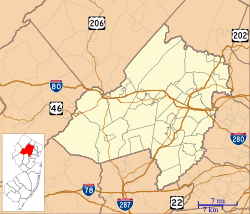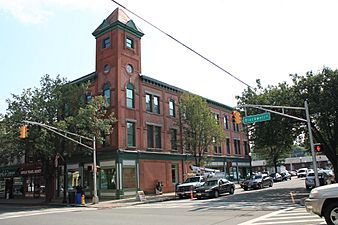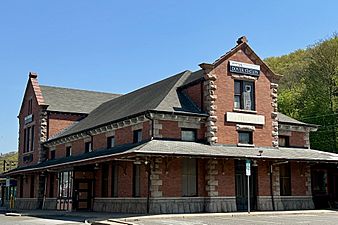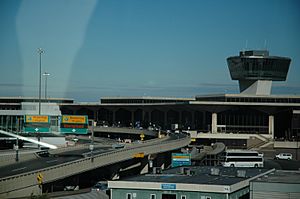Dover, New Jersey facts for kids
Quick facts for kids
Dover, New Jersey
|
||
|---|---|---|
|
Town
|
||

Blackwell Street Historic District, listed on the National Register of Historic Places
|
||
|
||
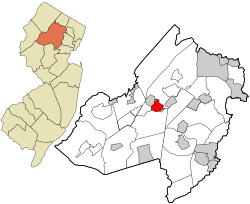
Location of Dover in Morris County highlighted in red (right). Inset map: Location of Morris County in New Jersey highlighted in orange (left).
|
||
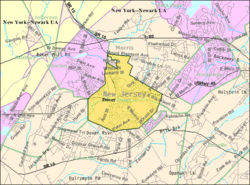
Census Bureau map of Dover, New Jersey
<mapframe text="Interactive map of Dover, New Jersey" zoom="8" width="250" height="250"> { "type": "ExternalData", "service": "geoshape", "ids": "Q1088760" } </mapframe> |
||
| Country | ||
| State | ||
| County | ||
| Incorporated | April 1, 1869 | |
| Independent | March 5, 1896 | |
| Named for | Dover, England or Dover, New Hampshire | |
| Government | ||
| • Type | Town | |
| • Body | Town Council | |
| Area | ||
| • Total | 2.73 sq mi (7.06 km2) | |
| • Land | 2.68 sq mi (6.93 km2) | |
| • Water | 0.05 sq mi (0.13 km2) 1.90% | |
| Area rank | 362nd of 565 in state 29th of 39 in county |
|
| Elevation | 558 ft (170 m) | |
| Population
(2020)
|
||
| • Total | 18,460 | |
| • Estimate
(2023)
|
18,435 | |
| • Rank | 148th of 565 in state 10th of 39 in county |
|
| • Density | 6,898.4/sq mi (2,663.5/km2) | |
| • Density rank | 68th of 565 in state 3rd of 39 in county |
|
| Time zone | UTC−05:00 (Eastern (EST)) | |
| • Summer (DST) | UTC−04:00 (Eastern (EDT)) | |
| ZIP Codes |
07801–07803, 07806, 07809
|
|
| Area code(s) | 973 | |
| FIPS code | 3402718070 | |
| GNIS feature ID | 0885196 | |
Dover is a town in Morris County, New Jersey. It is located on the Rockaway River. Dover is about 31 miles (50 km) west of New York City. It is also about 23 miles (37 km) west of Newark, New Jersey.
In 2020, the town's population was 18,460 people. This was the highest number of people ever counted in Dover. The population grew by 303 people since the 2010 census. Dover is a community where many different groups of people live. In 2010, almost 70% of the people identified as Hispanic. This was a big increase from 25% in 1980.
Contents
History of Dover
The land where Dover is today was first given to Joseph Latham in 1713. This land was part of a larger area bought from Native Americans. In 1722, Latham sold 527 acres (2.13 km²) to John Jackson from New York. Jackson built a home on the eastern part of his land.
At that time, there was a lot of iron ore nearby. Jackson built a forge to turn the iron ore into bars. These bars were then sent to places like Paterson for use in factories. However, a law called the Iron Act caused problems for Jackson. He went bankrupt in 1753, and his property was sold. Quaker Hartshorne Fitz Randolph bought Jackson's land.
Dover officially became a town on April 1, 1869. It was part of Randolph Township at first. Then, on March 5, 1896, it became fully independent. For a short time, it was called a city in 1896. But a court ruling changed it back to a town in 1899.
In the past, Dover was a busy industrial town. It had many iron and mill works, machine shops, and factories. These factories made things like stoves, boilers, and silk. Dover was also a port on the Morris Canal. This canal was used to transport goods. The town's name might come from Dover, England, or Dover, New Hampshire.
Geography of Dover
Dover covers a total area of 2.73 square miles (7.06 km²). Most of this area is land, about 2.68 square miles (6.93 km²). A small part, 0.05 square miles (0.13 km²), is water.
Dover is located near several other towns in Morris County. These include Mine Hill Township, Randolph, Rockaway Township, Victory Gardens, and Wharton.
People of Dover (Demographics)
| Historical population | |||
|---|---|---|---|
| Census | Pop. | %± | |
| 1880 | 2,958 | — | |
| 1900 | 5,938 | — | |
| 1910 | 7,468 | 25.8% | |
| 1920 | 9,803 | 31.3% | |
| 1930 | 10,031 | 2.3% | |
| 1940 | 10,491 | 4.6% | |
| 1950 | 11,174 | 6.5% | |
| 1960 | 13,034 | 16.6% | |
| 1970 | 15,039 | 15.4% | |
| 1980 | 14,681 | −2.4% | |
| 1990 | 15,115 | 3.0% | |
| 2000 | 18,188 | 20.3% | |
| 2010 | 18,157 | −0.2% | |
| 2020 | 18,460 | 1.7% | |
| 2023 (est.) | 18,435 | 1.5% | |
| Population sources: 1880–1920 1890–1910 1880–1930 1940–2000 2000 2010 2020 |
|||
In 2010, the town of Dover had 18,157 people living in it. There were 5,562 households, which are groups of people living together. The population density was about 6,765 people per square mile (2,612/km²).
Most of the people in Dover, about 69.4%, identified as Hispanic in 2010. This means Dover has a large Hispanic community. Many people in Dover have roots in countries like Colombia, Mexico, Puerto Rico, Ecuador, Honduras, and Peru.
The average age of people in Dover was 35.5 years old. About 21.6% of the population was under 18 years old. The average household had 3.21 people.
Places to Visit in Dover
Dover has several interesting historical sites.
- The Baker's Opera House is an old theater on Blackwell Street. It is listed on the National Register of Historic Places (NRHP).
- The Dover train station is also a historic building. It is listed on the NRHP.
- The Blackwell Street Historic District includes 52 historic buildings. This area is also listed on the NRHP.
Parks and Fun in Dover
Dover has many parks and places for recreation.
- Hedden County Park is a large park partly in Dover. It has picnic areas, paddle boats, playgrounds, and hiking trails.
- Hamilton Field is a sports area with a football field and soccer fields. It is mainly for school use.
- JFK Memorial Commons Park has a playground and a gazebo. It hosts town events like Christmas tree lighting and summer concerts. This park was built where an old canal basin used to be.
- Crescent Field has a new turf soccer field. It is where Dover's annual Colombian Festival takes place.
- Water Works Park has a baseball field and a picnic area. You can also access the Rockaway River here.
- Hurd Park is a quiet park with beautiful columns and a gazebo. It's a great spot for photos. The park also has statues and memorials for soldiers from different wars.
- Triangle Park is a small park downtown. It features "Story Poles" by Hudson Favell.
- Hooey Park and Richards Avenue Park are smaller neighborhood parks with playgrounds.
- Bowlby Park and King Field are used for Little League Baseball and soccer.
- Mountain Park is being developed for hiking trails.
Schools in Dover
The Dover School District serves students from pre-kindergarten through 12th grade. In the 2021–22 school year, about 3,448 students attended the five schools in the district.
The schools are:
- Academy Street Elementary School (grades K-6)
- East Dover Elementary School (grades K-6)
- North Dover Elementary School (grades PreK-6)
- Dover Middle School (grades 7-8)
- Dover High School (grades 9-12)
Students from Victory Gardens also attend Dover schools. Students in grades 7–12 from Mine Hill Township come to Dover schools as well.
There was once a Catholic school called Sacred Heart School in Dover. It closed in 2009 due to fewer students and financial issues.
Dover is also home to a special school called The Joe Kubert School of Cartoon and Graphic Art. It was started in 1976 by cartoonist Joe Kubert. It is the only school of its kind that focuses on cartooning and graphic art.
Getting Around Dover (Transportation)
Dover has many roads for getting around. In 2010, there were about 42.84 miles (68.94 km) of roads. Most of these roads are maintained by the town itself.
Major highways that go through Dover include U.S. Route 46 and New Jersey Route 15. You can also easily reach Interstate 80 from nearby towns.
Public Transportation in Dover
NJ Transit buses serve Dover with routes 875 and 880. These buses connect Dover to other areas.
You can also take NJ Transit trains from the Dover station. These trains are on the Morristown Line and Montclair-Boonton Line. They can take you to places like Hackettstown, Newark, Hoboken, and New York City.
Lakeland Bus Lines also provides bus service from Dover. You can travel to places like Sparta, Newton, and New York City. There is also bus service to Atlantic City on certain days.
The Morris County Department of Transportation runs a bus service along Route 46. This bus goes to Netcong and Mount Olive Township.
Air Travel Near Dover
Dover is about 15 minutes west of Morristown Municipal Airport. For bigger flights, Newark Liberty International Airport is about 40 minutes west.
Dover Community Life
The town of Dover has a lively downtown area around Blackwell Street. You can find many restaurants there, especially those owned by Hispanic families. They offer a variety of delicious ethnic foods. There are also places for sushi, pizza, coffee, and Irish and Italian food.
Dover is known as a "walking town." Most places in town are within a short walk of the downtown area. Most streets also have sidewalks, making it easy to walk around.
Famous People from Dover
Many interesting people have been born in, lived in, or are connected to Dover. Here are a few:
- Lois Barker (1923–2018), a baseball player in the All-American Girls Professional Baseball League.
- William F. Birch (1870–1946), a politician who represented New Jersey.
- Shane Davis, a comic book artist.
- Jim Duffy (born 1974), a college baseball coach.
- Joseph Kekuku (1874–1932), who invented the steel guitar.
- X. J. Kennedy (born 1929), a well-known writer and poet.
- Adam Kubert (born 1959), a cartoonist and teacher at The Kubert School.
- Andy Kubert (born 1962), also a cartoonist and teacher at The Kubert School.
- Joe Kubert (1926–2012), a famous cartoonist who started The Kubert School.
- Mike Leach (born 1976), a former NFL football player.
- Drew Miller (born 1984), a hockey player for the Detroit Red Wings.
- PES (born 1973), an Oscar-nominated director and animator.
- Reince Priebus (born 1972), a former chairman of the Republican National Committee.
- Sherry Ross (born c. 1954), a sports broadcaster.
- Gail Sontgerath (born 1944), a gymnast who competed in the 1960 Summer Olympics.
- Jyles Tucker (born 1983), a football player for the San Diego Chargers.
- Ava Ziegler (born 2006), a figure skater.
See also
 In Spanish: Dover (Nueva Jersey) para niños
In Spanish: Dover (Nueva Jersey) para niños



